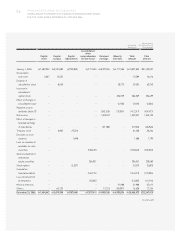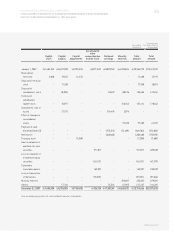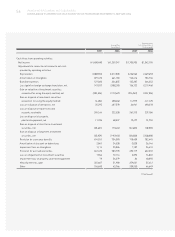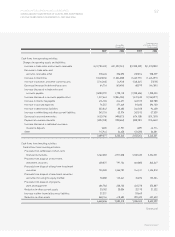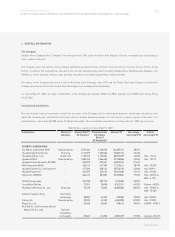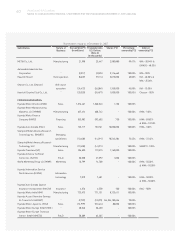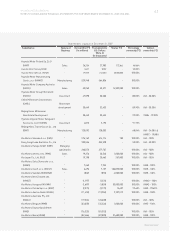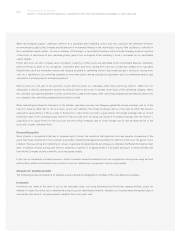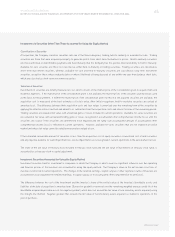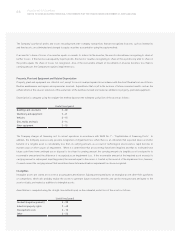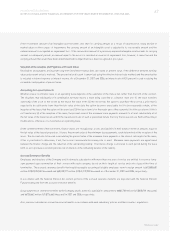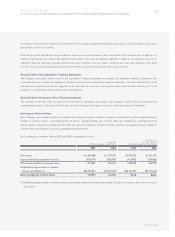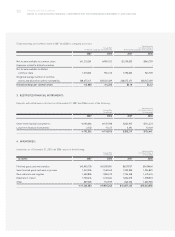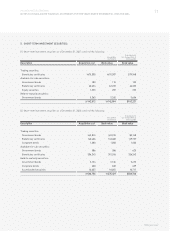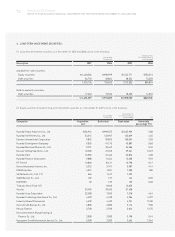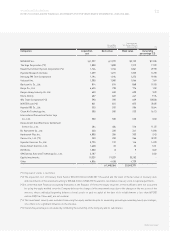Hyundai 2007 Annual Report Download - page 66
Download and view the complete annual report
Please find page 66 of the 2007 Hyundai annual report below. You can navigate through the pages in the report by either clicking on the pages listed below, or by using the keyword search tool below to find specific information within the annual report.
64 HYUNDAI MOTOR COMPANY
NOTES TO CONSOLIDATED FINANCIAL STATEMENTS FOR THE YEARS ENDED DECEMBER 31, 2007 AND 2006
When the Company acquires additional interests in a subsidiary after obtaining control over the subsidiary, the difference between
incremental price paid by the Company and the amount of incremental interest in the shareholders' equity of the subsidiary is reflected in
the consolidated capital surplus. In case a subsidiary still belongs to a consolidated economic entity after the Company disposes a portion
of the stocks of subsidiaries to non-subsidiary parties, gain or loss on disposal of the subsidiary’s stock is accounted for as consolidated
capital surplus.
Profits and losses on inter-company sales of products, property or other assets are eliminated in the consolidated financial statements
based on the gross profit or loss recognized. Unrealized gains and losses arising from sales by a controlling company to its subsidiary
(downstream sales) are eliminated entirely and charged (credited) to controlling interest, and unrealized gains and losses arising from
sales by a subsidiary to its controlling company or from transactions among subsidiaries (upstream sales) are eliminated entirely and
allocated to controlling interest and minority interest.
Minority interest is the part of net operation results and net assets of a subsidiary other than controlling interest. When net loss
attributable to minority shareholders exceeds the minority interest, the excess is charged to the equity of the controlling company. When
the subsidiary subsequently generates income, such income is added to the equity of the controlling company until the minority interest net
loss charged to the controlling company has been fully recovered.
When translating the financial statements of the affiliates operating overseas, the Company applied the foreign exchange rate as of the
investor’s balance sheet date to the associate’s assets and liabilities, the foreign exchange rate as of the date on which the investor
acquired its equity interest in the associate to the investor’s share of the associate’s equity interest, the foreign exchange rate as of each
transaction date to the remaining equity interest in the associate after excluding any increase in retained earnings after the investor’s
acquisition of its equity interest in the associate, and the foreign exchange rate as of the average rate for the pertinent period to the
associate’s income statement items.
Revenue Recognition
Sales of goods is recognized at the time of shipment only if it meets the conditions that significant risks and rewards of ownership of the
goods have been transferred to the customer, and neither continuing managerial involvement nor effective control over the goods sold is
retained. Revenue arising from rendering of services is generally recognized by the percentage-of-completion method at the balance sheet
date. In addition, revenue arising from interest, dividends or royalties is recognized when it is probable that future economic benefits will
flow into the Company and those benefits can be measured reliably.
In the case of subsidiaries in financial business, interest revenues earned on financial assets are recognized as time passes using the level
yield method, and fees and commissions in return for services rendered are recognized as services are provided.
Allowance for Doubtful Accounts
The Company provides an allowance for doubtful accounts based on management’s estimate of the collectibility of receivables.
Inventories
Inventories are stated at the lower of cost or net realizable value, cost being determined by the moving average method, except for
materials in transit for which cost is determined using the specific identification method. Valuation loss incurred when the market value of
an inventory falls below its carrying amount is added to the cost of goods sold.


